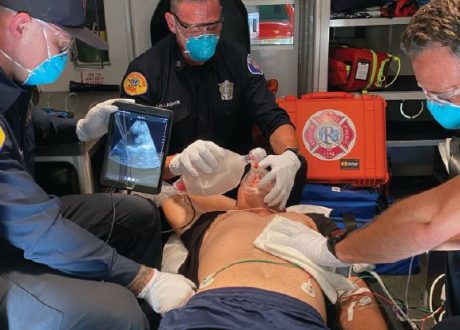The RACECAT Randomized Clinical Trial
Question In patients experiencing suspected large-vessel occlusion stroke in a nonurban area, is there a difference in neurological outcomes between those who are transported to the closest local stroke center vs directly to a thrombectomy-capable referral center?
Findings In this randomized clinical trial that included 1401 patients with suspected large-vessel occlusion stroke in nonurban Catalonia, Spain, transportation to a thrombectomy-capable referral center vs a local stroke center resulted in an odds ratio of 1.03 for reduced disability at 90 days, as measured by the modified Rankin Scale. This was not statistically significant.
Meaning In nonurban areas in Catalonia, Spain, where the closest hospital was not capable of performing thrombectomy, there was no significant difference in 90-day neurological outcomes between patients transported to a local stroke center first vs directly to a thrombectomy-capable referral center in patients with suspected large-vessel occlusion acute ischemic stroke; these findings require replication in other settings.
Importance In nonurban areas with limited access to thrombectomy-capable centers, optimal prehospital transport strategies in patients with suspected large-vessel occlusion stroke are unknown.
Objective To determine whether, in nonurban areas, direct transport to a thrombectomy-capable center is beneficial compared with transport to the closest local stroke center.
Design, Setting, and Participants Multicenter, population-based, cluster-randomized trial including 1401 patients with suspected acute large-vessel occlusion stroke attended by emergency medical services in areas where the closest local stroke center was not capable of performing thrombectomy in Catalonia, Spain, between March 2017 and June 2020. The date of final follow-up was September 2020.
Interventions Transportation to a thrombectomy-capable center (n = 688) or the closest local stroke center (n = 713).
Main Outcomes and Measures The primary outcome was disability at 90 days based on the modified Rankin Scale (mRS; scores range from 0 [no symptoms] to 6 [death]) in the target population of patients with ischemic stroke. There were 11 secondary outcomes, including rate of intravenous tissue plasminogen activator administration and thrombectomy in the target population and 90-day mortality in the safety population of all randomized patients.
Results Enrollment was halted for futility following a second interim analysis. The 1401 enrolled patients were included in the safety analysis, of whom 1369 (98%) consented to participate and were included in the as-randomized analysis (56% men; median age, 75 [IQR, 65-83] years; median National Institutes of Health Stroke Scale score, 17 [IQR, 11-21]); 949 (69%) comprised the target ischemic stroke population included in the primary analysis. For the primary outcome in the target population, median mRS score was 3 (IQR, 2-5) vs 3 (IQR, 2-5) (adjusted common odds ratio [OR], 1.03; 95% CI, 0.82-1.29). Of 11 reported secondary outcomes, 8 showed no significant difference. Compared with patients first transported to local stroke centers, patients directly transported to thrombectomy-capable centers had significantly lower odds of receiving intravenous tissue plasminogen activator (in the target population, 229/482 [47.5%] vs 282/467 [60.4%]; OR, 0.59; 95% CI, 0.45-0.76) and significantly higher odds of receiving thrombectomy (in the target population, 235/482 [48.8%] vs 184/467 [39.4%]; OR, 1.46; 95% CI, 1.13-1.89). Mortality at 90 days in the safety population was not significantly different between groups (188/688 [27.3%] vs 194/713 [27.2%]; adjusted hazard ratio, 0.97; 95% CI, 0.79-1.18).
Conclusions and Relevance In nonurban areas in Catalonia, Spain, there was no significant difference in 90-day neurological outcomes between transportation to a local stroke center vs a thrombectomy-capable referral center in patients with suspected large-vessel occlusion stroke. These findings require replication in other settings.










